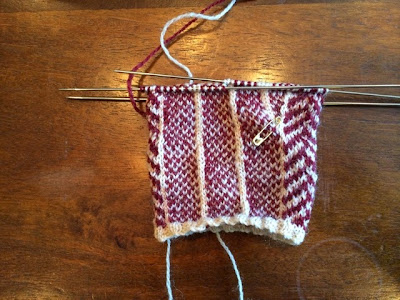This summer, I began with knitting a wool/linen three-quarter sleeve pullover. This was a success: love the
yarn and the pattern.
Yarn: Leinen Los (70% wool and 30% linen blend) by Schoppel-Wolle
Pattern: Gemini by Jane Richmond, from Kintty
Needles: 4 mm
I partially followed modification applied by the designer herself on her later version to transform the tee to three-quarter length sleeves. Also, I decided to use lace pattern throughout along the neck.
To do lace pattern all around the neck turned out to be rather simple. First race round: yo twice,
k2tog, k2tog, yo twice, k2tog … The first yo is for the last yo of
the round. You will see when you try it yourself. On the next round: One
has to move the marker for the beginning of round every round and move the
marker one stitch ahead so that the first yo will go to the end of the round.
Following the notes from the author’s modified version with ¾ length fitted sleeves, I stopped increasing stitches
once there are 66 stitches (for size M) for sleeves, while I kept increasing stitches per instruction for front and back bodice. The author recommends the following stitch count for fitted sleeves: 56
(60, 66, 74, 80, 88, 94) stitches.
Sleeve shaping for 3/4 length sleeve knitted flat: Increase stitches at the beginning and the end of the 66 stitches
for seam allowances. Knit even for 12 rows. Worked paired decreases on the next and every 10th row to 48 sts. Knit one more row. Switch to 3.75 mm needles and knit in 1 x 1 ribbing for 6 rows. Total of 100 rows were knitted for sleeves.
Cast off loosely.
Applied slipped chain stitches along the
inner cast on edge along the neckline to reduce the neck opening.

It is too warm to wear the pullover outdoor now, but it is useful indoor where AC blasts.
Next, a cotton/silk peplum cardigan. I used long-since-discontinued Fable yarn in red/orange color,
named Goldilocks and the three bears. I even had perfect buttons for the yarn.

The design is for worsted weight yarn with 20 stitches per 10 cm while my yarns's gauge is 16 stitches with 5 mm needles. I knitted the dimension of size M by following stitch counts for size XS and adjusted the row counts as
I went on. I did not have enough yarn to knit the full sleeve length and I knitted sleeves somewhat shorter. The cardigan is intended for summer and I am fine with shorter sleeves.
And, next up will be Estonia dress! I am all excited
about this project.

























.jpg)























.JPG)



